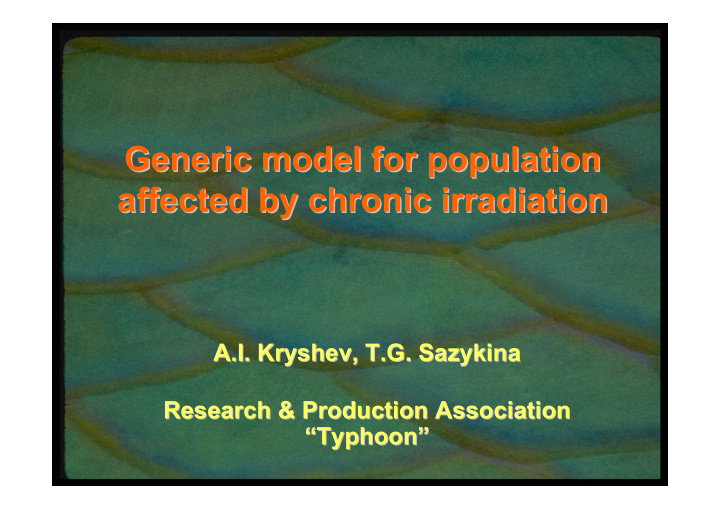



Generic model for population Generic model for population affected by chronic irradiation affected by chronic irradiation A.I. Kryshev Kryshev, T.G. , T.G. Sazykina Sazykina A.I. Research & Production Association Research & Production Association “Typhoon Typhoon” ” “
The objective of the study was development of a mathematical model, which simulates adequately the development of radiation effects in an isolated, chronically exposed population at different dose rates.
The following umbrella endpoints were taken into consideration: � morbidity, � reproduction, � decrease of the population size
The effects caused by chronic irradiation in population are considered to be a result of superposition of three major processes – � creation of damage by radiation, � recovery of damage by means of repairing mechanisms, � natural growth of population
‘Repairing system’ is considered as a complex entity (a kind of “black box”), which repairs damage caused by ionizing radiation and other stressors.
Let us consider an isolated generic population, living under ideal conditions (no predators, no limitation by food, optimal temperature and other environmental factors), which is exposed to chronic ionizing radiation with a dose rate p (mGy/day)
We assume, that organisms composing the exposed population may be in one of the following states: � undamaged, � reversibly damaged, � lethally damaged
Reversible damages are recovered by the repairing mechanisms, the repairing pool is spent for the repairing processes. Effect on morbidity of organisms in the population depends on decrease of the repairing pool (in % from its initial value). The ionizing radiation also cause a direct damage to the repairing pool itself.
Reproduction system increases number of normal organisms in the population, but itself is affected by the ionizing radiation
A system of differential equations describing the effects of chronic radiation exposure on fish population can be written as: dx = − α + κ + µ ⋅ − ⋅ px yR ( x x ) F max dt dy = α − ε − κ px y yR dt dR = µ ⋅ ⋅ − − κ ⋅ − α ⋅ ⋅ R ( R R ) yR p R r max r r dt dF = − α ⋅ ⋅ − µ ⋅ ⋅ − + µ ⋅ ⋅ − ( ) ( ) p F F x x F F F f max f max dt = = = = x ( 0 ) x ; y ( 0 ) 0 ; R ( 0 ) R ; F ( 0 ) F max max max
Effect of the chronic radiation exposure on the survival was estimated using the ratio X / X max. Effects on reproduction were described by the ratio F/Fmax. Effects on morbidity were described by the ratio R/Rmax.
1 0,8 Survival of population, % 0,6 0,4 0,2 0 0 20 40 60 80 100 Dose rate, mGy/day Decrease of population size with the increase of dose rate
1 0,8 Repairing pool, % 0,6 0,4 0,2 0 0 5 10 15 20 25 Dose rate, mGy/day Decrease of repairing capacity with the increase of dose rate
Dose rate – effect curve in general form: 1 = X ( P ) α + 1 ( P / P ) 50 In our model: P 50 =32.5 mGy/day; α =5.5
1,2 Empiric formula 1 Model calculation Survival decrease, % 0,8 0,6 0,4 0,2 0 0 20 40 60 80 100 Dose rate, mGy/day Dose-effect curves obtained from the general empiric formula and from the dynamic population model
Conclusions Generic population model with repairing of radiation damage can adequately describe the observed dose-effect relationship; Considerable radiation effects on the survival of an isolated population are predicted to be at dose rates higher than 20 mGy/day
Recommend
More recommend